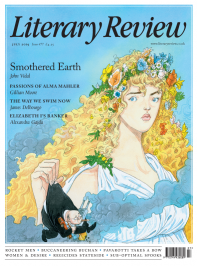John Keay
Imprints of Persia
India in the Persianate Age, 1000–1765
By Richard M Eaton
Allen Lane 512pp £30
As India powers its way up the world GDP rankings, a case is being made for recasting its national history as ‘world history’. By looking beyond India’s boundaries and focusing on the global context of its power struggles, this American-led approach promises to reveal unexpected commonalities and find space for groups previously marginalised on grounds of gender, race or caste. Richard Eaton’s India in the Persianate Age is a fine example of this method. Ambitious enough to make sense of the often bloody and mostly unfashionable ‘middle period’ of South Asian history, it is also inclusive enough to acknowledge the contribution of, for instance, African mercenaries to the rise of the Deccan sultanates and authoritative enough to ruffle the feathers of today’s Hindu nationalists.
Eaton has form in the last of these. Not long ago he was pilloried as a ‘negationist’ (the Indian equivalent of a ‘denier’) for suggesting that, instead of ‘tens of thousands’, fewer than a hundred Hindu temples were desecrated by iconoclasts during the seven to eight centuries of

Sign Up to our newsletter
Receive free articles, highlights from the archive, news, details of prizes, and much more.@Lit_Review
Follow Literary Review on Twitter
Twitter Feed
It wasn’t until 1825 that Pepys’s diary became available for the first time. How it was eventually decrypted and published is a story of subterfuge and duplicity.
Kate Loveman tells the tale.
Kate Loveman - Publishing Pepys
Kate Loveman: Publishing Pepys
literaryreview.co.uk
Arthur Christopher Benson was a pillar of the Edwardian establishment. He was supremely well connected. As his newly published diaries reveal, he was also riotously indiscreet.
Piers Brendon compares Benson’s journals to others from the 20th century.
Piers Brendon - Land of Dopes & Tories
Piers Brendon: Land of Dopes & Tories - The Benson Diaries: Selections from the Diary of Arthur Christopher Benson by Eamon Duffy & Ronald Hyam (edd)
literaryreview.co.uk
Of the siblings Gwen and Augustus John, it is Augustus who has commanded most attention from collectors and connoisseurs.
Was he really the finer artist, asks Tanya Harrod, or is it time Gwen emerged from her brother’s shadow?
Tanya Harrod - Cut from the Same Canvas
Tanya Harrod: Cut from the Same Canvas - Artists, Siblings, Visionaries: The Lives and Loves of Gwen and Augustus John by Judith Mackrell
literaryreview.co.uk